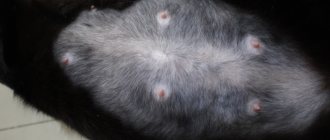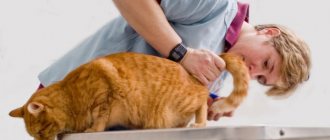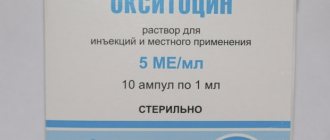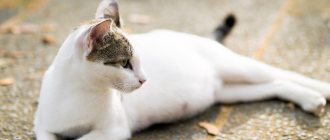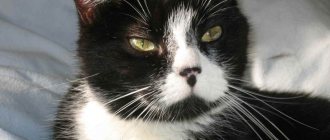Surgical manipulation - caesarean section, is performed in cats and dogs when problems arise during the birth process. As a rule, the main indication for surgical intervention is the inability to give birth physiologically. There may be planned operations, but most often emergency surgery is performed.
If the cat is not kept by the owner for breeding, veterinary experts recommend sterilization during cesarean section, which will avoid diseases in the reproductive sphere or minimize the risks of their occurrence.
Recovery from cat anesthesia after sterilization
After surgery, monitoring the cat's temperature is required! An ordinary mercury thermometer is suitable for this.
- At first, there is a lack of coordination of movement , involuntary running, and lameness.
- The cat may stand unsteadily on its paws , fall over on its side, or try to remove the restraining bandage or blanket.
- Possibly a plaintive meow .
- Uncontrollable urination often occurs .
- For persistent and prolonged nausea and vomiting, consult a veterinarian. Such signs may indicate complications that have arisen.
- , an increase in body temperature may occur . You should constantly touch your pet's nose. With hyperthermia, it will be dry and hot to the touch. If in doubt, you should measure her temperature with a thermometer. You cannot use a regular mercury thermometer for this; it is recommended to use an electronic device. The temperature of cats and cats is measured rectally. It is better if the owner has an assistant, since the animal does not like such a procedure and will resist, which can result in damage to the integrity of the suture and painful sensations for the operated patient. The tip should be inserted into the anus and held until the signal. If the temperature persists for more than four hours after waking up, going to the clinic is mandatory.
In the first time after recovery from anesthesia, there is a lack of coordination of movement.
Do not feed or water your cat after anesthesia
You should not feed and water your pet immediately after waking up.
Water can be given four hours after sterilization. If the patient overslept during this time and has not yet recovered from anesthesia, then it is permissible to offer a drink immediately after waking up.
4 hours after surgery, the cat can be given water.
It is recommended to feed twenty-four hours after the operation. Often the operated pet has a reduced appetite or no appetite at all. Force feeding is not allowed. The pet will decide when she can eat.
If a lack of appetite and activity for a fairly long period, and at the same time there are other alarming symptoms, you should immediately contact the clinic.
In the first days, do not make changes to your cat's diet.
It is recommended to feed with your usual food, as before the procedure. When consuming dry food before sterilization, it is recommended to give your pet a special post-operative dry food designed specifically for such cases. If there is a rapid heartbeat or breathing, or increased blood pressure, this is a sign of a painful syndrome in the wound area.
After the procedure, the cat should be fed with the cat’s usual food.
In total, the cat should fully recover within 24 hours. If this does not happen, you need to consult a doctor.
A day after the operation, the cat fully recovers.
And a little about secrets.
The story of one of our readers, Irina Volodina:
I was especially distressed by my eyes, which were surrounded by large wrinkles, plus dark circles and puffiness. How to completely remove wrinkles and bags under the eyes? How to deal with swelling and redness? But nothing ages or rejuvenates a person more than his eyes.
But how to rejuvenate them? Plastic surgery? I found out - no less than 5 thousand dollars. Hardware procedures - photorejuvenation, gas-liquid peeling, radio lifting, laser facelift? A little more affordable - the course costs 1.5-2 thousand dollars. And when will you find time for all this? And it's still expensive. Especially now. Therefore, I chose a different method for myself.
Before taking your cat for sterilization surgery, you should be aware that after the intervention, the animal’s body temperature may decrease. To do this, it is necessary to provide the patient with warmth by placing a warm towel or felt flap under her.
How long does a cat sleep after anesthesia?
During the period after anesthesia, the cat will be lethargic and drowsy.
After anesthesia, the cat can sleep for up to seven hours. Often, an operated animal can wake up earlier than the agreed time.
The first few hours, or even the whole day after waking up, the pet will recover from anesthesia. During this period, she will be lethargic, drowsy, and may display aggression. Nausea and vomiting may occur. The first sign of impending vomiting is frequent licking.
What should be done first after sterilization?
The first thing to do after the operation is to put on a post-operative blanket for her to avoid damage to the stitches by the pet itself.
After sterilization, the cat needs to be put on a post-operative blanket.
- Should only be removed to treat the section site..
- It is worth laying a soft, warm bedding on the floor.
- Under no circumstances should the animal be placed on a raised surface - a sofa, bed, or chair.
- It is worth placing your pet on its right side to avoid unnecessary pressure on the heart.
After anesthesia, animals will not always be able to orient themselves in space, and a sharp jerk or jump is possible, which will inevitably lead to a fall and damage to the sutures.
Eyes and anesthesia
During anesthesia, it is recommended to drip ophthalmic solutions into the cat's eyes.
Cats are kept with their eyes open during anesthesia.
In order to prevent the cat's retina and mucous membrane from drying out or being damaged by lighting that is aggressive to the cat's retina, it is recommended to drip ophthalmic solutions into the eyes. In this case, you should independently press the pet’s lower and upper eyelids against each other every half hour.
Do this until the blinking reflex is restored and the animal begins to blink on its own or closes its eyes.
Increased temperature after anesthesia
If the body temperature has increased, the operated animal should be force-fed, carefully pouring liquid from a pipette or syringe without a needle, to avoid drying out the mouth.
When the temperature rises, you need to force the cat to drink liquid.
The apartment must be warm; you cannot open windows or doors for ventilation - a draft will provoke unwanted complications.
What to do if kittens cry?
Kittens should sleep or nurse 90% of the time. If they cry or whine, this is usually not the case. Uterine infection, lack of milk or low quality milk are the most common causes of anxiety and ill health in kittens. The cat's entire litter may die if one of these complications progresses. If you have any concerns about their health, you should take both the cat and kittens to the vet.
If your cat doesn't have enough of her own milk at first, you can use artificial milk for the first one or two days. Your veterinarian should advise you on a suitable milk replacer for kittens, as well as a feeding bottle. In case of emergency, you can use the following formula: 1 cup milk, 1 tablespoon corn oil, 1 pinch salt and 3 egg yolks (without whites). Mix until smooth. The mixture should be fed 30 ml per 1/8 kg of kitten weight per 24 hours. This volume should be divided into 3-5 feedings. The average weight of a newborn kitten is 1/8 kg.
It is advisable that care for kittens begin immediately after birth, but a healthy newborn kitten can survive without complications for 12 hours without feeding. However, if the newborn is weak or dehydrated, feeding should begin as quickly as possible.
What is it used for?
Caesarean section is especially often used in first-born and very old cats. In the first case (especially if the kittens are from a large cat), the diameter of the birth canal may be too small for a natural and safe birth, and in the second, the old animal may not be able to withstand the “natural” course of this process. In addition, indications for the use of this surgical intervention may be pathologies in the development of fetuses identified by ultrasound or their exceptionally large size. In addition, if one or two kittens lie completely across the birth canal, it will almost certainly not be possible to do without a caesarean section.


